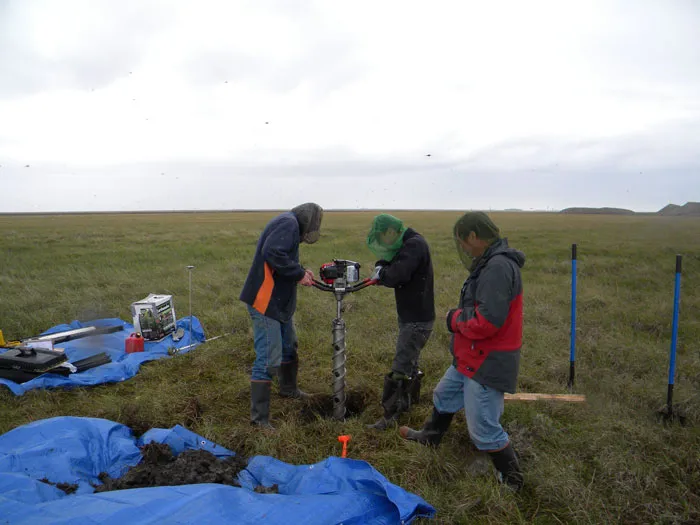By Jane Beitler
The decline of summer sea ice in the Arctic punctuates a long warming trend that is amplified in the north. While some scientists study the loss of sea ice and its effect on climate patterns, other scientists have been monitoring ground that was once permanently frozen. It is also thawing, with both local and global consequences. NSIDC scientist Kevin Schaefer and colleagues studied the trend to see how much carbon this thawing ground would add to the atmosphere in the future—in the form of greenhouse gases that will accelerate the warming of Earth's climate.
In cold storage
Permafrost covers 25 percent of the ground in the Northern Hemisphere, mostly above the Arctic Circle. Permafrost is ground that has stayed frozen for at least two years in a row, and often for many hundreds or even thousands of years. Harder to monitor than snow and ice on the surface, it also hides many secrets. The permafrost contains a large amount of vegetation, primarily partially decayed plant roots, that has remained frozen in a thick layer near the surface since the last ice age. Locked in this layer are some 1,672 gigatons of carbon from the decayed vegetation, more than twice the amount of carbon currently in the atmosphere. Like broccoli in the freezer, it is stable as long as it remains frozen, but when removed from the freezer, will quickly thaw and break down. As it decays, some of the carbon is released to the atmosphere as carbon dioxide and methane, adding to the increasing carbon from manmade sources that are causing climate to warm.
Coming soon to a latitude near you
Scientists have long been watching and measuring permafrost, which is difficult because of its extent and remoteness. Satellites do not easily detect frozen ground, so laborious field studies have been used to study and inventory permafrost. Scientists do not expect permafrost to thaw steadily, but instead to thaw and periodically refreeze, making it harder to plot out how it would release its carbon over time. Based on what they had learned about permafrost thawing, Schaefer and team were able to set up a computer model that combined temperature trends and other data to estimate how permafrost would thaw and release carbon in the future.
The study concluded that one- to two-thirds of Earth's permafrost will disappear by the year 2200, releasing an amount of carbon equivalent to half the amount of carbon that has been released into the atmosphere since the dawn of the industrial age. Even at the lower end of the estimates, the amount of carbon released is expected to produce significant additional atmospheric warming. While not good news for the Earth, this knowledge helps more accurately gauge where global climate is headed.
References
Schaefer, K., T. Zhang, L. Bruhwiler, A. P. Barrett. 2011. Amount and timing of permafrost carbon release in response to climate warming. Tellus, doi:10.1111/j.1600-0889.2011.00527.x
